Best place to put a router for best WiFi speeds: An Ultimate Guide
Do you know what the best place to put a router is?
WiFi has a limited range, especially when passing through concrete and metal.
So, if the WiFi in some areas of your home looks slow, chances are your router might not be in the optimum spot.
For this reason, choosing where to put wifi router is crucial.
In today’s post, we’ll provide you with 7 helpful tips to find the best location for wifi router for the best WiFi signal; check them out now!

What is the best place to put a router?
How do WiFi signals work?
Finding the ideal place for a WiFi router won't be a problem anymore after reading this article.
However, you must first have a fundamental understanding of how WiFi networks operate before discovering best place for router.
Nowadays, 2.4 GHz and 5 GHz bands are where most WiFi routers broadcast their signals.
The 2.4 GHz spectrum offers less bandwidth than the 5 GHz band but is better at penetrating solid objects and traveling farther.
AM and FM radio, cell phones, and TV remotes all fall under the non-ionizing portion of the electromagnetic spectrum, and so do 2.4 GHz and 5 GHz bands.
You must, thus, consider potential interference from other devices producing electromagnetic spectrum noise while selecting best placement for wifi router.

2.4 GHz and 5 GHz bands
Besides, each WiFi router features one or more antennas for signal transmission.
These antennas are sometimes integrated into the design of routers.
But more frequently, they protrude from the device like the rabbit ears on an old television and may be rotated and adjusted.
A signal is produced by an antenna as a series of electromagnetic waves.
Most WiFi routers use omnidirectional antennas, so the signals go in all directions.
However, they are strongest as oriented perpendicular to the antenna in an oval pattern.
In other words, the antenna would go straight through the hole if you considered the signal to be in the form of a donut.

Router antennas
How to choose the best place to put router?
Where to place a router?
The objective behind a proper placement of wifi router inside your house is to avoid interference and make the most of the WiFi signal's shape.
Here are some fundamental guidelines to follow.
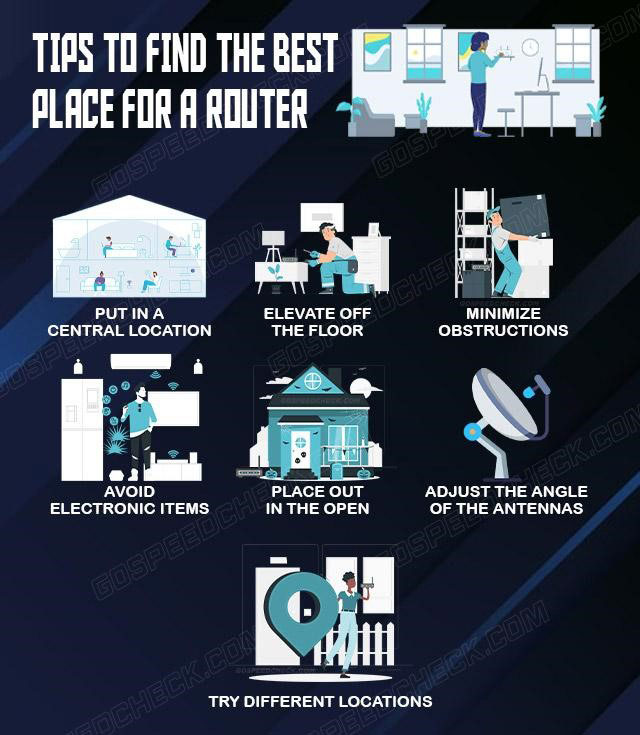
A guide on where to place the router
See more: How to share WiFi password?
Put in a central location
Routers that use WiFi do not broadcast in just one direction; rather, they emit signals in waves resembling water ripples.
You can't expect your router, which is currently positioned in a corner, to evenly cover your home or office.
Therefore, wifi placement should be in the most central area of your home, which is the best way to ensure that every room is within signal range.
If placed close to the center, most contemporary routers have sufficient range to cover an entire moderately sized home.
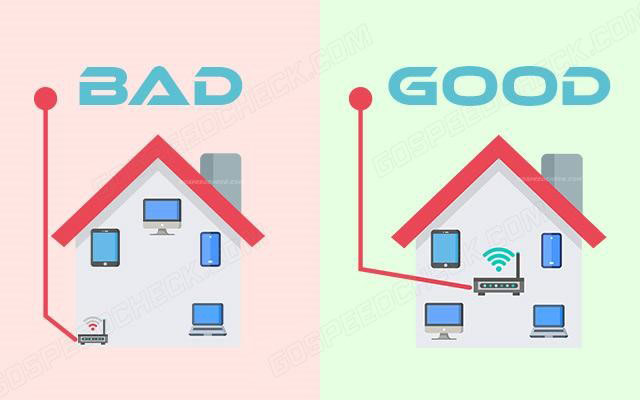
You should put a router centrally
The only case this rule is broken is when the central location is either hard to reach or inappropriate due to a violation of other rules outlined in this article.
Elevate off the floor
Elevate your WiFi router off the floor and install it on a wall or place it on a shelf to help the signal it emits spread across your house or office.
You don't want the foundation to consume half of the coverage bubble that WiFi routers' omnidirectional antennas create, right?
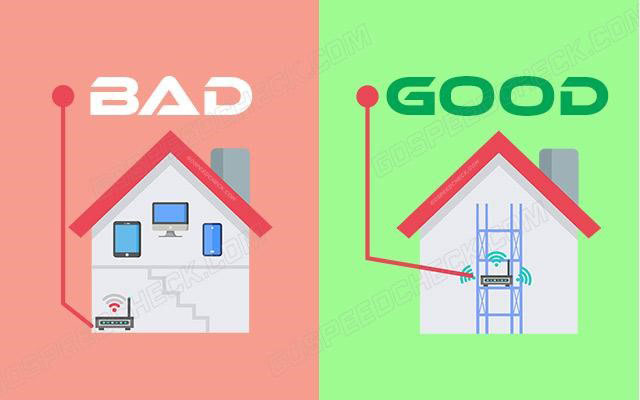
You should put your router off the floor
The owners of multistory homes are an exception to this regulation.
The best place to put router in 2 story house would be close to the ceiling on the first floor or close to the floor on the second floor.
In addition, to ensure even coverage in a 3 story home, simply position the router in the middle of the second floor.
In either scenario, keep in mind that furniture arrangement can interfere with your signal.
Minimize obstructions
WiFi transmissions have a low enough frequency to penetrate materials like walls.
Though some obstructions, like walls and ceilings, may be unavoidable, others, like big appliances, can usually be avoided without too much effort.
But if eliminating physical obstructions entirely is impossible, then at the very least avoid those that have the worst effect on WiFi signals.

Avoid physical obstacles as much as possible
The ideal solution would be for your device and the router to be in a direct line of sight.
The best wifi position should be in somewhere that its signal must pass the fewest amount of walls to reach devices in other rooms.
Avoid electronic items
The best place to put wifi router should be a position that doesn’t near electronic items.
Electronic devices may interfere with your WiFi signal just like walls and big objects do.
Electronic gadgets that use the same part of the electromagnetic spectrum as WiFi can interfere with its signals.
These devices include wireless security cameras, cordless phones, microwave ovens, baby monitors, and other smart home appliances.
Your WiFi signal quality may also be negatively impacted by other nearby WiFi networks, particularly if they share the same WiFi channel as your router.
So, try to stay clear of as many of these WiFi interferences as you can if you want the best router placement.
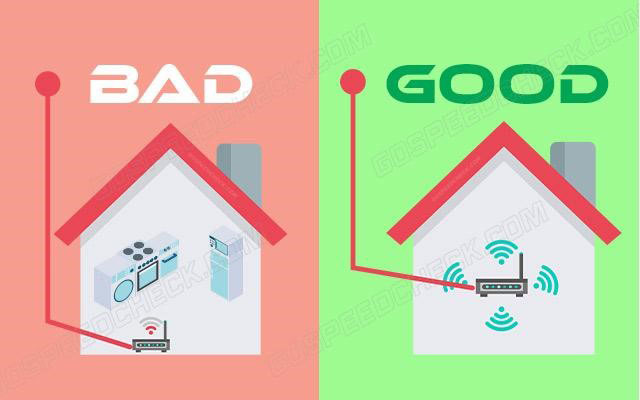
Your router should be put far from electronic devices
Place out in the open
How to hide wifi router on floor is a popular question.
Several people choose to conceal their router behind a sofa or in a cupboard, maybe as a hangover from the cumbersome days of routers.
However, a good general rule is to keep your router visible at all times because hiding it will reduce its efficacy and negatively affect your connection.
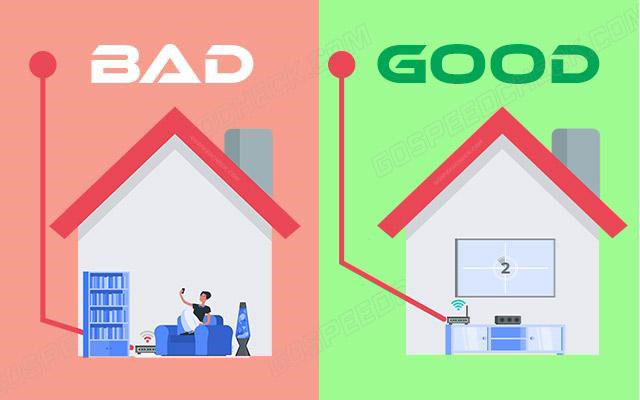
Always put your router in the open
Adjust the angle of the antennas
The wifi router antenna position is also worth considering for the best wifi placement.
To enhance the strength of your WiFi connection, try moving the antennas on the router if it has adjustable ones.
You may increase horizontal reach by angling your router's antennas upward.
Plus, placing your antenna sideways may enable you to receive a stronger signal upstairs.
Also, think about getting bigger, higher-gain antennas to replace the ones on your router.
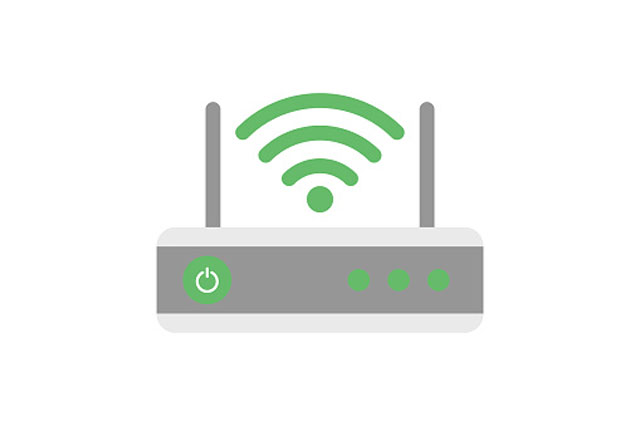
Consider changing the antennas’ angle
Although the region your WiFi signal covers is wide and rounded, the signal itself travels in a straight line.
This implies that the signal cannot deflect if something is obstructing the signal between the router and your device.
Try different locations
Router placement should not be in the first place.
Try moving your router around to see if the signal quality or stability on your multiple devices improves.
You can use this to determine the best location of router for the strongest and most consistent WiFi connection.
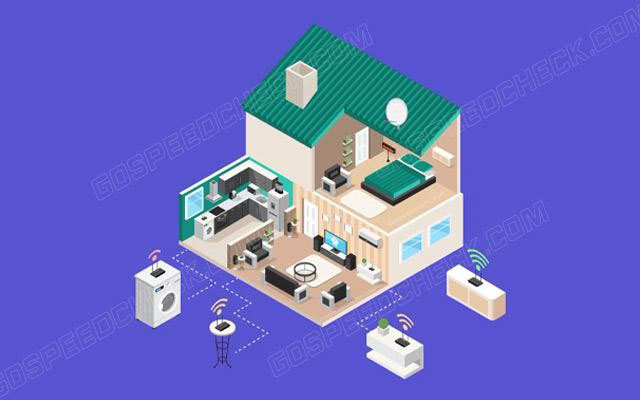
Try various positions to put a router
See more: Backhaul Internet
What is a WiFi dead zone?
A dead zone is just a spot where WiFi coverage is present in your home, apartment, workplace, or any other location.
Nevertheless, your gadget detects no signal when you attempt to connect.
The WiFi on a gadget will cease operating and you won't get a signal if you move it into a dead wifi spot in house.
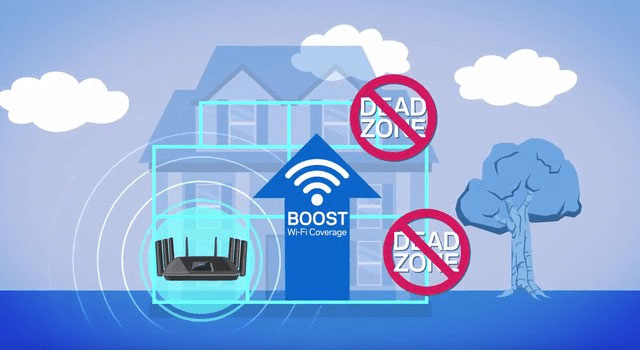
WiFi dead spots
Then what causes WiFi dead zones in your house?
Any obstruction that blocks WiFi radio waves results in a dead spot.
There may be a dead zone where the WiFi signal cannot reach the opposite corner of an office or house if your router is on one of the building's corners.
Your connection may also be hampered by other devices.
For example, a microwave oven limits WiFi signals while it is operating and old cordless phones cause WiFi dead zones when in operation.
Similarly, if your neighbors are close by and have WiFi networks set up on the same channel as yours, it may cause interference and weaken your signal.
Dead zones may develop around your house as a result.
How to deal with WiFi dead zones?
Even if you've located the perfect location to put a router, wifi dead zones can still occur.
If so, there are still some further strategies you may try as to how to make WiFi faster.
Look at the info below to find the best way to fix wifi dead spots.
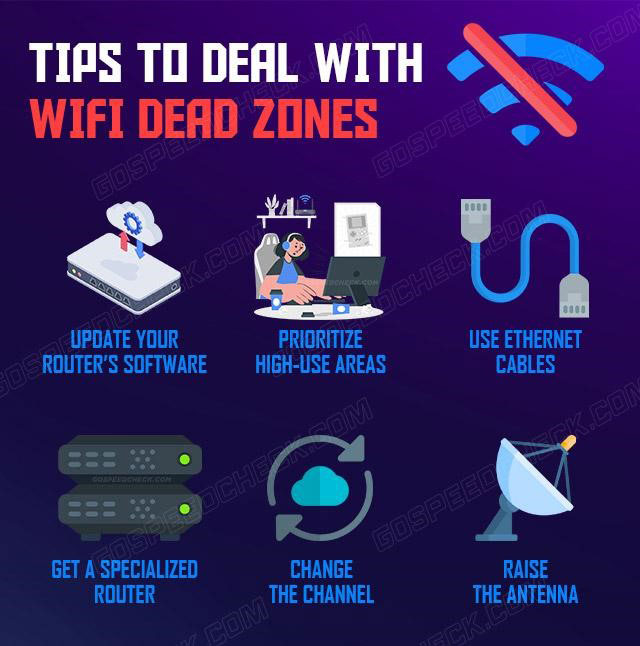
How to solve WiFi dead spots?
Update your router’s software
You can consider updating the firmware of the router first.
Getting the most recent firmware version can frequently fix connection and speed issues.
You can easily look for it on the manufacturer's website.
Below is an example of how to upgrade the NETGEAR router’s software:
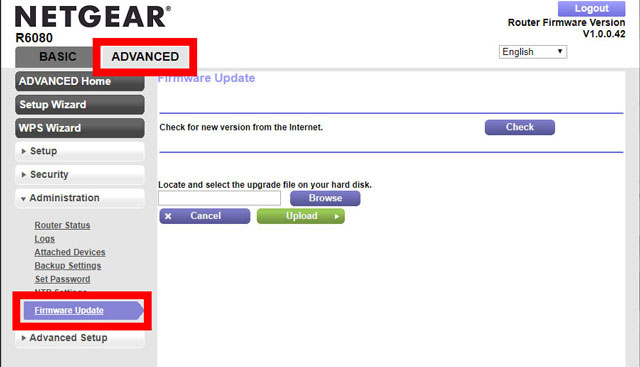
Updating the router’s software can help fix dead zones
Prioritize high-use areas
Even if a central location is the greatest method to access every room in your home, you can have a stronger attachment to some areas.
For instance, you might want to position your router closer to your home office and living room if they are on the same side of the house.
It is ok even if it results in a lower signal in the kitchen.
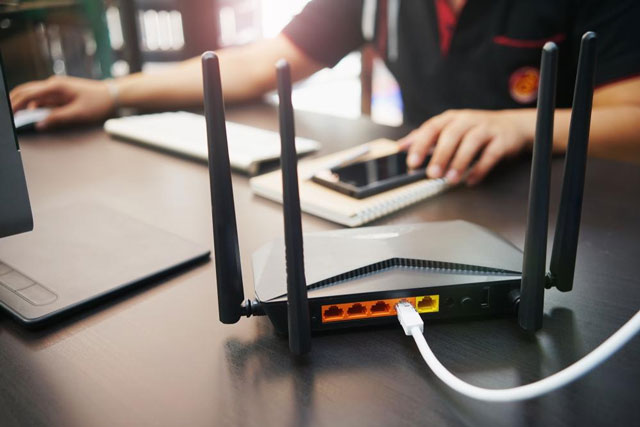
You should give high-use areas priority
Although having WiFi dead zones in your home is never ideal, it's wise to plan where they will be located if you must have them.
Use Ethernet cables
With a long enough Ethernet cable, you can direct your Internet around any obstruction to avoid dead spots in house wifi.
It's indeed better, unlike WiFi signals that are sent in a straight line.
For people who truly want to place their computer in that tiny corner without WiFi, this tip works nicely, though it's less practical for really large homes.

You can use a wired cable to connect to the Internet
Get a specialized router
How to fix internet dead spots?
You may consider buying a different router if your house is simply too large for your current router to handle or has an excessive amount of dead zones.
With a single router, a substantially broader area may be covered thanks to long-range routers.
Additionally, there are mesh routers and WiFi extenders that can help you send your signal over a wide area and through barriers.
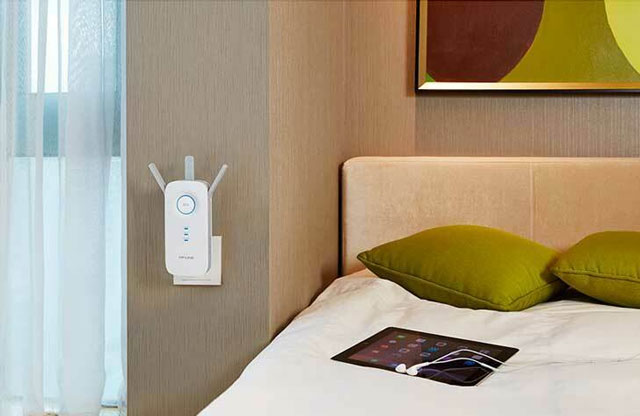
A WiFi extender
Change the channel
Most contemporary routers are dual-band, which means they can broadcast WiFi networks using the 2.4 GHz and 5 GHz channels, as mentioned earlier.
Therefore, using the same channel as your neighbors' routers may cause both to sluggishly slow down.
If so, switching the channel might be beneficial.

Changing your router’s channel
Since the 5GHz channel is less often used than the 2.4GHz channel, it should be virtually traffic-free and operate much faster.
Also, don't forget to test your Internet speed after switching to 5GHz to determine if it has improved.
Raise the antenna
Last but not least, ensure that the antenna on your router is pointed upward and not horizontally.
If it doesn't work, you can upgrade your router's antenna.
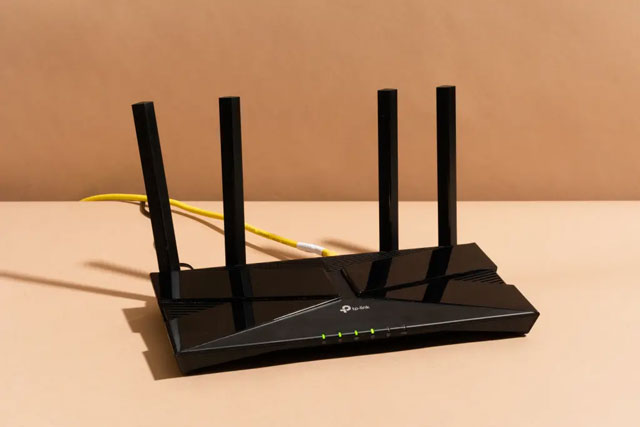
Keep your antenna pointing upward
Unluckily, there is no software helping you change the antenna, so simply replace it by screwing on and restarting your router.
A TV or other media component should not be placed close to or behind you to preserve wireless performance.
Many people assume that wifi works downstairs but not upstairs.
However, the higher the better when positioning the router because wireless signals are generally stronger below the router than they are above it.
If possible, put the modem/router upstairs if you intend to use the same one upstairs and downstairs.
You should put your router with a clear line of sight 5-7 feet off the ground as its radio waves expand out and downward from their point of origin.
The range of your signal is improved by placing your router much off the ground.
Conclusion
That’s all for today's post. Having gone through this useful information, we hope you know how to avoid getting dead zones in your house and most importantly, know what is the best place to put a router. If you find this post interesting, comment below to let us know.


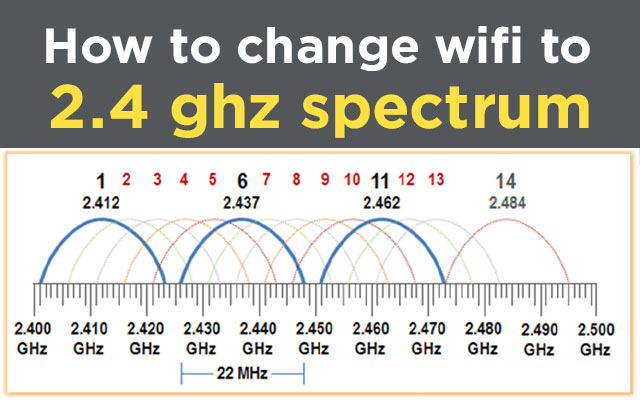


10 Comments
Charles Miller
Kinda off topic, but does opening a window near an internet router lets the wifi out?
Leave a Comment
Your email address will not be published. Required fields are marked *MySpeed
You are not letting the WiFi out. It will still be received inside. It does not escape, leaving no signal indoors. Nor does it lower your signal indoors. WiFi is not air conditioning.
Leave a Comment
Your email address will not be published. Required fields are marked *Keith Newman
I wonder will the Wi-Fi signal on the roof of a tall building be influenced by the weather condition? I want to use wireless network to transfer data, either WIFI or 3G. Which will be less influenced by the weather, especially rainstorms?
Leave a Comment
Your email address will not be published. Required fields are marked *MySpeed
The anwswer is yes. Even for the best links, if you had so heavy rain. the link may go down for couple of minutes
Leave a Comment
Your email address will not be published. Required fields are marked *Waylon Edwards
Another great post! But will my computer receive bad internet if it is directly upstairs of the router?
Leave a Comment
Your email address will not be published. Required fields are marked *MySpeed
If you are using WiFi to connect, you may need to adjust the antenna on the router. If you are directly above it, you might be in the “donut hole”. So tilt the antenna so it’s sideways.
Leave a Comment
Your email address will not be published. Required fields are marked *Edgar Long
Love the way you describe the good and bad router position! So easy to follow
Leave a Comment
Your email address will not be published. Required fields are marked *MySpeed
Thanks! Awesome to hear that
Leave a Comment
Your email address will not be published. Required fields are marked *Lennox Brooks
Does having your internet router near your monitor impact your internet network? Ever since I got my second monitor, my internet is really laggy. My router is right next to it.
Leave a Comment
Your email address will not be published. Required fields are marked *MySpeed
Maybe WiFi shadows from the monitor. WiFi signal won’t pass through a monitor, so if it is between the router and a device, the performance can suffer. Alternatively, the laggy behavior is your computer being unable to handle the rendering for the second monitor, or being short of memory now.
Leave a Comment
Your email address will not be published. Required fields are marked *Leave a Comment
Your email address will not be published. Required fields are marked *